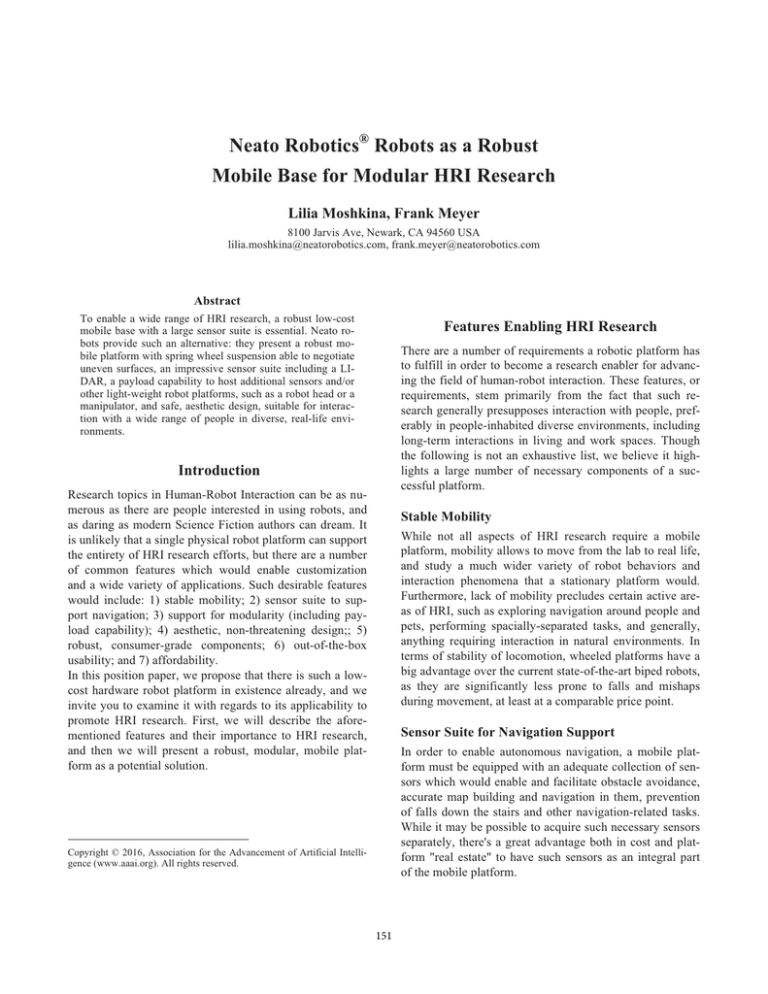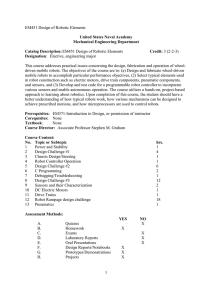
Neato Robotics® Robots as a Robust
Mobile Base for Modular HRI Research
Lilia Moshkina, Frank Meyer
8100 Jarvis Ave, Newark, CA 94560 USA
lilia.moshkina@neatorobotics.com, frank.meyer@neatorobotics.com
Abstract
To enable a wide range of HRI research, a robust low-cost
mobile base with a large sensor suite is essential. Neato robots provide such an alternative: they present a robust mobile platform with spring wheel suspension able to negotiate
uneven surfaces, an impressive sensor suite including a LIDAR, a payload capability to host additional sensors and/or
other light-weight robot platforms, such as a robot head or a
manipulator, and safe, aesthetic design, suitable for interaction with a wide range of people in diverse, real-life environments.
Features Enabling HRI Research
There are a number of requirements a robotic platform has
to fulfill in order to become a research enabler for advancing the field of human-robot interaction. These features, or
requirements, stem primarily from the fact that such research generally presupposes interaction with people, preferably in people-inhabited diverse environments, including
long-term interactions in living and work spaces. Though
the following is not an exhaustive list, we believe it highlights a large number of necessary components of a successful platform.
Introduction
Research topics in Human-Robot Interaction can be as numerous as there are people interested in using robots, and
as daring as modern Science Fiction authors can dream. It
is unlikely that a single physical robot platform can support
the entirety of HRI research efforts, but there are a number
of common features which would enable customization
and a wide variety of applications. Such desirable features
would include: 1) stable mobility; 2) sensor suite to support navigation; 3) support for modularity (including payload capability); 4) aesthetic, non-threatening design;; 5)
robust, consumer-grade components; 6) out-of-the-box
usability; and 7) affordability.
In this position paper, we propose that there is such a lowcost hardware robot platform in existence already, and we
invite you to examine it with regards to its applicability to
promote HRI research. First, we will describe the aforementioned features and their importance to HRI research,
and then we will present a robust, modular, mobile platform as a potential solution.
Stable Mobility
While not all aspects of HRI research require a mobile
platform, mobility allows to move from the lab to real life,
and study a much wider variety of robot behaviors and
interaction phenomena that a stationary platform would.
Furthermore, lack of mobility precludes certain active areas of HRI, such as exploring navigation around people and
pets, performing spacially-separated tasks, and generally,
anything requiring interaction in natural environments. In
terms of stability of locomotion, wheeled platforms have a
big advantage over the current state-of-the-art biped robots,
as they are significantly less prone to falls and mishaps
during movement, at least at a comparable price point.
Sensor Suite for Navigation Support
In order to enable autonomous navigation, a mobile platform must be equipped with an adequate collection of sensors which would enable and facilitate obstacle avoidance,
accurate map building and navigation in them, prevention
of falls down the stairs and other navigation-related tasks.
While it may be possible to acquire such necessary sensors
separately, there's a great advantage both in cost and platform "real estate" to have such sensors as an integral part
of the mobile platform.
Copyright © 2016, Association for the Advancement of Artificial Intelligence (www.aaai.org). All rights reserved.
151
Support for Modularity
Affordability
An anthropomorphic mobile platform may be impressive,
and allows to conduct certain types of research, but it will
limit the variety of research which it can be used to conduct, as in the near future, it is far more likely that the robots which share human spaces are indeed not anthropomorphic. For example, the most common robotic consumer
product, apart from toys, is a robot vacuum cleaner, and
delivery robots are also making headway (e.g., Savioke's
Relay; Relay URL). Therefore it would be desirable to
have a mobile base which can be used by itself, or could
carry additional components, such as a small manipulator,
a robot head, a laptop or an entire other stationary robot
(e.g., Romibo; Origami URL, or Jibo; Jibo URL). Such a
platform could also support addition of any researchspecific sensors, such as a camera, Kinect, and others.
This is the aspect particularly relevant to the present venue.
The vast majority of currently available research platforms,
especially anthropomorphic mobile platforms, are prohibitively expensive, and only better funded research labs can
afford them. This is partly due to the "economies of scale"
issue: the smaller the demand, the more expensive the
item. Leveraging a commercially available product would
provide definite cost advantages, especially if the producing company is willing to design specific accessories and
components to augment their product.
Neato Robots as Mobile HRI Base
Neato Robotics (Neato URL), a consumer electronics
company in Silicon Valley, has a line of commercially
available user-friendly low-cost robots, which we believe
satisfy all the requirements delineated above to serve as a
modular base for HRI research. Neato robots are small,
light-weight vacuum cleaners suitable for indoor navigation and safe enough to be used by general populace; see
Figure 1 for a top and bottom view of the latest model,
Neato Botvac Connected. Neato can provide a public API
to access all available sensors and wheel motors, so that
third parties can easily create their own software which can
control the robot and produce desired behaviors. In fact,
ROS community has been using Neato robots extensively,
and there is a Neato ROS node already available to the
general public. Furthermore, its low cost and impressive
sensors made Neato robots the platform of choice for
teaching a hands-on robotics class at CMU’s Robotics Institute (Alonzo, K.).
Aesthetic, Non-Threatening Design
Unless a particular study examines the effects of form factor on people's perception of it, a robot platform used in
HRI research has to follow a pleasant, non-threatening
design to make the interaction with the robot more natural,
realistic and not filled with anxiety or fear for one's safety.
For example, though an impressive platform otherwise,
Xitome's MDS robot can be rather intimidating, is not altogether safe to be around, and may appear “creepy”. In
close interactions with people it would be better to avoid
creating such unfavorable impressions.
Robust, Safe, Consumer-Grade Components
In the past, many research labs have traditionally used either home-built robots, or those made just for research purposes. Such robots were by design not meant to last, and
had issues with using and maintaining them. As HRI research is moving out of the lab and into the real world, and
from minutes in duration to months, it is increasingly important to have a platform which can withstand long-term,
real-life interaction without falling apart or presenting danger to research participants.
Drop Sensorss
Laser
er Range
Finder
Removable
Bin
S
Spring
Wheell
Suspension
Casters
Out-of-the-Box Usability
Figure 1: Top and Bottom View of Neato Botvac Connected.
HRI research is interdisciplinary, and can involve anthropologists, sociologists, psychologists, user researchers, and
even marketing specialists, who may not be computersavvy enough to program robots for their experiments.
Therefore it is a big plus to have a robot platform which
can be used out-of-the-box, without having to write a line
of code, especially for conducting Wizard-of-Oz experiments.
A Neato robot is D-shaped, about 33 cm in diameter,
stands 10 cm high, and weighs 3.7 kg. It has a long-lasting
high capacity Lithium Ion battery, allowing longer experiments without having to recharge the robot. It also provides a micro-USB port for easy sensor data and motor
commands transfer.
The following features make Neato Botvac Connected an
ideal mobile robot base for conducting extensive HRI research:
152
• Robust, Safe, Consumer-Grade Components. Neato
robots are a commercial product, which has robust, welltested chassis, sensors and other components. They are
rated for general consumer use, and have successfully
passed IES Testing for consumer electronic products in
their category. Being a commercial product, they are
generally fool-proof, with all electronic components
safely contained in the chassis, and have high reliability.
• Out-of-the-box Applicability. Neato’s newest addition,
Botvac Connected, has WiFi capability allowing users to
teleoperate the robot remotely, using a smart phone or a
tablet (both Android and iOS are supported). This provides a great opportunity for those researchers who are
unable or time-constrained to do significant programming to use the robot out-of-the-box, controlling it remotely in Wizard-of-Oz experiments. As Neato also has
speakers, a combination of navigation and dialoguebased interaction can be explored without a significant
time investment.
• Stable Mobility. Neato has 2 spring-based suspension
wheels in the front, and 2 caster wheels in the back. It
can navigate over all types of floor surfaces, easily negotiate uneven surfaces, and climb over low obstacles.
Though not specifically designed for outdoor navigation,
it can handle most types of benign terrain (e.g., sidewalks, short grass, etc., though not wet surfaces).
• An Impressive Embedded Sensor Suite. First and
foremost, all Neato robots are equipped with a laser
range finder located on top of the robot surface, which
allows robust navigation under most lighting conditions.
In addition to the laser range finder, the robot also has a
full range of other sensors in support of navigation: an
accelerometer to detect tilt, 2 proximity (drop) sensors
facing downwards to detect negative obstacles, a proximity (“wall”) sensor in the right side to detect obstacles
and allow precise wall/obstacle following, 4 bumper sensors for safely navigating around obstacles below the laser level, and finally, 2 magnetic sensors to create virtual
boundaries for the robot to avoid using magnetic strips
(included with the robot). All the sensor data are available to researchers/developers via API commands.
• Support for Modularity. Neato robots have a removable dust bin, which provides protected space for an embedded inexpensive board for basic computation, such as
a Raspberry Pi II, or additional power supplies for extra
sensors or any other additions to the base. The robots can
carry a payload of up to 3.5 kg (8 lb), without significantly impacting their mobility. With a platform placed
on top of the robot, it can accommodate additional modular components, such as any additional sensors, a small
manipulator, a laptop, or even another robot not capable
of independent navigation, without interfering with the
laser range finder.
Figure 3: Teleoperation app for Neato Botvac Connected
• Affordability. For a robot capable of autonomous navigation and equipped with a laser range finder and a large
number of other sensors, Neatos are surprisingly affordable. The prices range from $399.99 for an earlier model
(XV Signature) to under $700 for the newest Neato Botvac Connected. This is over 5 times less the price of the
nearest research platform providing similar affordances
(minus the sensor suite) – a Turtlebot costs over $2,000.
Conclusion
Figure 2: Neato Botvac equipped with a payload platform
(left), and carrying an iPad and a webcab (right)
In this paper, we highlighted a number of requirements
essential for a robotic platform used to conduct extensive
and diverse Human-Robot Interaction research, namely,
stable mobility, sensor suite to support navigation, support
for modularity, aesthetic, non-threatening design, robust,
consumer-grade components, out-of-the-box usability, and
affordability. We also showed how a commercially available low-cost hardware platform from Neato Robotics® admirably fulfills all of these requirements, and we could like
• Aesthetic, Non-Threatening Design. Neato robots were
designed with people in mind, to operate around them
and fit well in their day-to-day lives. They have a
smooth profile, have no sharp corners, and in general,
produce an impression of technology well-suited to human environments. Being targeted as an electronic appliance, they naturally avoid any “uncanny valley” phenomena, and are non-threatening even to children.
153
to propose it for consideration during the upcoming AAAI
Symposium as potentially suitable base for HRI research.
References
Relay URL. “Meet Relay”, http://www.savioke.com, accessed on
01/22/2016
Origami URL. “Origami Robotics”, http://origamirobotics.com,
accessed on 01/22/2016
Jibo URL. “Jibo”, https://www.jibo.com, accessed on 01/22/2016
Neato URL. “Neato Robotics”, www.neatorobotics.com, accessed
on 01/22/2016
Alonzo, K., “Intro To Mobile Robot Programming”,
www.frc.ri.cmu.edu/users/alonzo/teaching/16x62/16x62.html,
accessed on 01/22/2016
154





